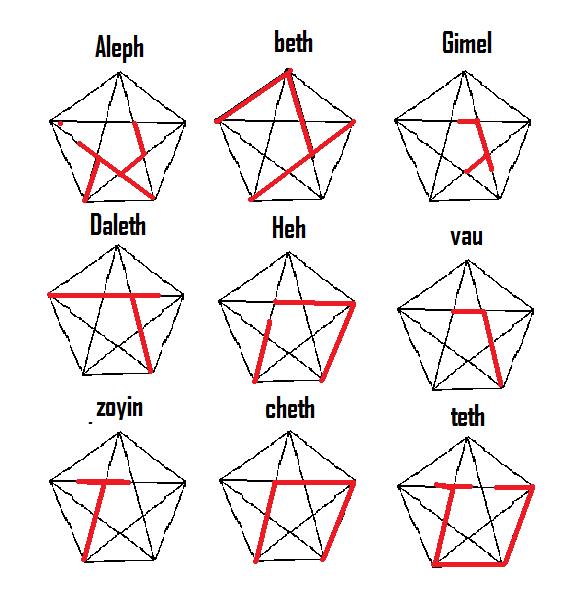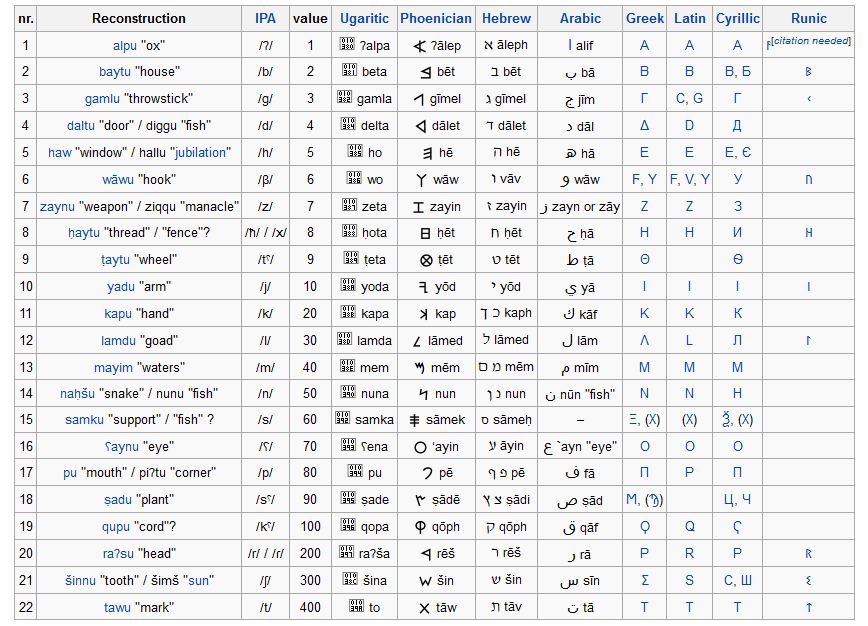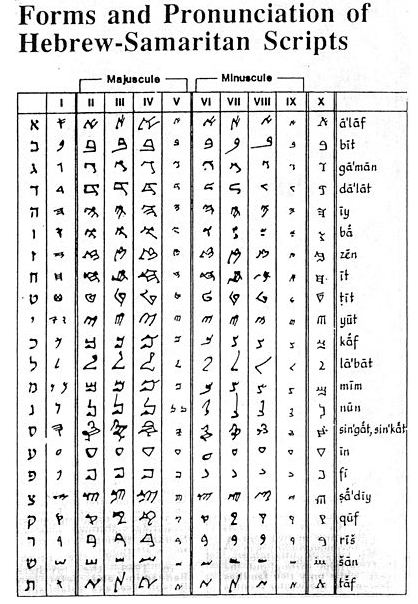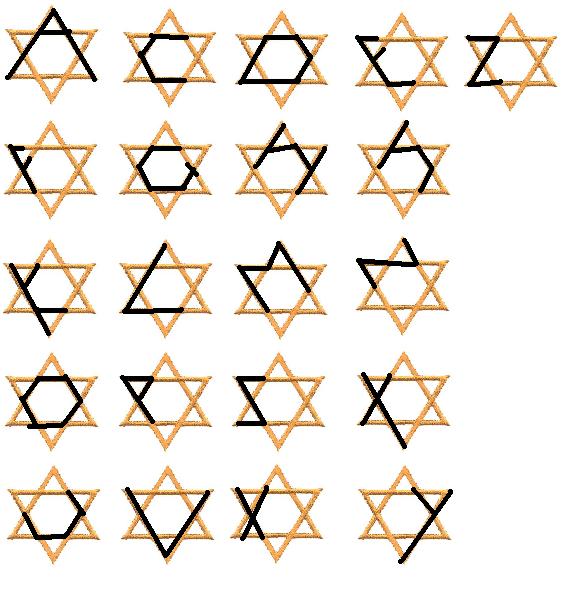It looks like you're using an Ad Blocker.
Please white-list or disable AboveTopSecret.com in your ad-blocking tool.
Thank you.
Some features of ATS will be disabled while you continue to use an ad-blocker.
share:
reply to post by DeadSeraph
Well that is a valid argument, but other that following something like that example, what might be a better suggestion as to how those symbols would have been formed?
It is assumed that there are only 22 letters for example. What if there are really twice as many in reality, but we were not taught those. I'd think there would have to be some sort of uniformity in creating things as all things are, but it would be interesting to find out if there is a better explanation than this. Personally right now I'd go with Occum's razor and just stick with this until a better explanation can be made.
Well that is a valid argument, but other that following something like that example, what might be a better suggestion as to how those symbols would have been formed?
It is assumed that there are only 22 letters for example. What if there are really twice as many in reality, but we were not taught those. I'd think there would have to be some sort of uniformity in creating things as all things are, but it would be interesting to find out if there is a better explanation than this. Personally right now I'd go with Occum's razor and just stick with this until a better explanation can be made.
Originally posted by renegadeloser
Alphabet Alpha-bet Aleph Bet
www.isawthelightministries.com...
heavenawaits.wordpress.com...
www.truthcontrol.com...
More links with that image.
heavenawaits.wordpress.com...
www.truthcontrol.com...
More links with that image.

Doing things like this is a valuable mental exercise, much like puzzle solving. You should note that I too am a student of the mysteries. I think this shows how easy this is to do with many geometric figures. I don't think that there is a direct relationship between the star of david, and the form of the letters in the aleph beth.
edit on 10-8-2012 by renegadeloser because: to add
reply to post by TheMatrixusesYou
alpha aleph , beth beta , gimel gamma , daleth delta. These alphabets are clearly related.
alpha aleph , beth beta , gimel gamma , daleth delta. These alphabets are clearly related.
reply to post by ErroneousDylan
Are you meaning to discredit by those links, or add to the discussion and veracity of the OP?
I ask because some would take those links as 'evidence' of a conspiracy or 'hoax'.
Are you meaning to discredit by those links, or add to the discussion and veracity of the OP?
I ask because some would take those links as 'evidence' of a conspiracy or 'hoax'.
Originally posted by TheMatrixusesYou
reply to post by DeadSeraph
Well that is a valid argument, but other that following something like that example, what might be a better suggestion as to how those symbols would have been formed?
It is assumed that there are only 22 letters for example. What if there are really twice as many in reality, but we were not taught those. I'd think there would have to be some sort of uniformity in creating things as all things are, but it would be interesting to find out if there is a better explanation than this. Personally right now I'd go with Occum's razor and just stick with this until a better explanation can be made.
The problem is that the hebrew alphabet is ancient, and the star of david, while ancient, was only recently adopted as the symbol for Israel, and the OP knows this.
The OP knows the significance of the symbol (at least I trust he does based on reading his other posts), and what he has attempted to do here, simply doesn't work like he wants it to. I can break up the English alphabet to fit a hexagram, that doesn't make it legitimate. I like that word, btw....
HEXagram.
Originally posted by TheMatrixusesYou
reply to post by DeadSeraph
Well that is a valid argument, but other that following something like that example, what might be a better suggestion as to how those symbols would have been formed?
It is assumed that there are only 22 letters for example. What if there are really twice as many in reality, but we were not taught those. I'd think there would have to be some sort of uniformity in creating things as all things are, but it would be interesting to find out if there is a better explanation than this. Personally right now I'd go with Occum's razor and just stick with this until a better explanation can be made.
22 letters, and 10 sayings, with these did God speak creation into being. This is essential kabbalah. 32 paths of wisdom they are called. 32 with which God speaks. There are 32 teeth in the human mouth. 3 mother letters ah, mmm, shhh (aleph, mem shin). 3 parts of the human mouth used for speaking throat, ah, aleph; teeth, shhh, shin; lips, mmmm, mem.
edit on 10-8-2012 by renegadeloser because: (no reason given)
reply to post by renegadeloser
The kabbalah is a great interest of mine. I am still in the process of finding works and texts on it. Interesting that you touch on the significance of numbers into the making of the human anatomy. We have 11 true pairs of rib( the 12th isn't made of bone), 22 bones in our skull and cranium, and there are 33 vertebrae in the human spine. These make up the basis for the Master Numbers.
The kabbalah is a great interest of mine. I am still in the process of finding works and texts on it. Interesting that you touch on the significance of numbers into the making of the human anatomy. We have 11 true pairs of rib( the 12th isn't made of bone), 22 bones in our skull and cranium, and there are 33 vertebrae in the human spine. These make up the basis for the Master Numbers.
reply to post by VeritasAequitas
Wow that's extremely interesting. From my inspection of a wikipedia page it appears there are only 24 vertebra however, 7 cervical, 12, and 5 lumbar. This is still interesting quabalistically, there being 7 double letter, 12 simple letter, and 3 mother letters. The mother letters don't seem to fit unless you realize that shin is a triple letter. It having 3 yods, connected to the base by lines, so 1 for aleph, 1 for mem, and 3 for shin, makes five.
There are two source documents from which the modern schools drew their knowledge. Sepher Yetzirah is one. It has the oldest manuscript ever found, circa A.D. 300 if I'm not mistaken. The other is the Zohar, which is in aramaic, first manuscript and puplishing somewhere in the 17th century. Both of these have references by name in the talmud earlier than this however. The legend going that a rabbi whose people had been wiped out wrote it down in a cave before dying. It's supposed to have been an oral tradition passed only from father to son before that.
There are certainly other documents from the dark ages and earlier which are of note. Most of them are written in language so obtuse as to be almost unintelligible however. There are also many modern works, post 19th century, which are quite interesting.
Wow that's extremely interesting. From my inspection of a wikipedia page it appears there are only 24 vertebra however, 7 cervical, 12, and 5 lumbar. This is still interesting quabalistically, there being 7 double letter, 12 simple letter, and 3 mother letters. The mother letters don't seem to fit unless you realize that shin is a triple letter. It having 3 yods, connected to the base by lines, so 1 for aleph, 1 for mem, and 3 for shin, makes five.
There are two source documents from which the modern schools drew their knowledge. Sepher Yetzirah is one. It has the oldest manuscript ever found, circa A.D. 300 if I'm not mistaken. The other is the Zohar, which is in aramaic, first manuscript and puplishing somewhere in the 17th century. Both of these have references by name in the talmud earlier than this however. The legend going that a rabbi whose people had been wiped out wrote it down in a cave before dying. It's supposed to have been an oral tradition passed only from father to son before that.
There are certainly other documents from the dark ages and earlier which are of note. Most of them are written in language so obtuse as to be almost unintelligible however. There are also many modern works, post 19th century, which are quite interesting.
edit on 10-8-2012 by renegadeloser because: to add
reply to post by renegadeloser
The 33 degrees of Scottish Rite Freemasonry, also represents the 33 vertebrae that your Kundalini must rise, in order to reach enlightenment.. Thank you for the references to works on the kabbalah. I have a few articles in my Theosophy folder, regarding it so far, but I also know that the Tree of Life, incoporates the chakra centers into them.
The 33 degrees of Scottish Rite Freemasonry, also represents the 33 vertebrae that your Kundalini must rise, in order to reach enlightenment.. Thank you for the references to works on the kabbalah. I have a few articles in my Theosophy folder, regarding it so far, but I also know that the Tree of Life, incoporates the chakra centers into them.
reply to post by renegadeloser
Oh I see. It seems there are 33 when you include the 5 in fused in the sacrum. What you say about the kundaline makes sense considering it's meant to sleep, ready to rise, in the sacrum.
Oh I see. It seems there are 33 when you include the 5 in fused in the sacrum. What you say about the kundaline makes sense considering it's meant to sleep, ready to rise, in the sacrum.
reply to post by renegadeloser
Correct. You have a good grasp of the arcane knowledge. Now, use this to figure out the allegory of the Garden of Eden.
Hint: It has to do a great deal with what I just told you.
Correct. You have a good grasp of the arcane knowledge. Now, use this to figure out the allegory of the Garden of Eden.
Hint: It has to do a great deal with what I just told you.
edit on 10-8-2012 by VeritasAequitas because: (no reason given)
I like this a lot. This could give religious researchers the ability to gain a more primitive understanding of deity. I am counting 27 characters on
a hebrew chart from google, but i only see 24 on the op. Going to study this a bit.
edit on 8/10/2012 by ibanezroxor because: append and
question
The basic constructs of most alphabets could be shown as comprised from basic geometry though the Hebrew alphabet evolved from Phoenician.
There are similarities in most primitive alphabets like Runic and Chinese, in as such the characters were derived from everyday things that were most relevant then, such as tree, river, man, horse, water, ice.
en.wikipedia.org...



There are similarities in most primitive alphabets like Runic and Chinese, in as such the characters were derived from everyday things that were most relevant then, such as tree, river, man, horse, water, ice.
en.wikipedia.org...
d Chart showing details of four alphabets' descent from Phoenician abjad, from left to right Latin, Greek, original Phoenician, Hebrew, Arabic. The Phoenician and Aramaic alphabets, like their Egyptian prototype, represented only consonants, a system called an abjad. The Aramaic alphabet, which evolved from the Phoenician in the 7th century BCE as the official script of the Persian Empire, appears to be the ancestor of nearly all the modern alphabets of Asia: The modern Hebrew alphabet started out as a local variant of Imperial Aramaic. (The original Hebrew alphabet has been retained by the Samaritans.)[8][9] The Arabic alphabet descended from Aramaic via the Nabataean alphabet of what is now southern Jordan. The Syriac alphabet used after the 3rd century CE evolved, through Pahlavi and Sogdian, into the alphabets of northern Asia, such as Orkhon (probably), Uyghur, Mongolian, and Manchu. The Georgian alphabet is of uncertain provenance, but appears to be part of the Persian-Aramaic (or perhaps the Greek) family.
Samaritan is a direct descendant of the Paleo-Hebrew alphabet, which was a variety of the Phoenician alphabet in which large parts of the Hebrew Bible were originally penned. All these scripts are believed to be descendants of the Proto-Sinaitic script. That script was used by the ancient Israelites, both Jews and Samaritans. The better-known "square script" Hebrew alphabet traditionally used by Jews is a stylized version of the Aramaic alphabet which they adopted from the Persian Empire (which in turn was adopted from the Arameans). After the fall of the Persian Empire, Judaism used both scripts before settling on the Aramaic form. For a limited time thereafter, the use of paleo-Hebrew (proto-Samaritan) among Jews was retained only to write the Tetragrammaton, but soon that custom was also abandoned.



edit on 10-8-2012 by theabsolutetruth because: (no reason given)
the magan david,or,the seal of solomon is too 'new' to the jews to be used in this manner.
pretty cool observation though!
pretty cool observation though!
Many hold the view that the six pointed star originated from the shield of King David, perhaps reminiscent of the shape of the shield or as an emblem upon it. However, historical sources dispute this claim and the star does not appear in any early Jewish literature or artwork. The menorah (candelabra) seems historically to have been more prevalent as a symbol. There is evidence that what is known today as the Star of David was used in the Middle East and North Africa as a good luck symbol. If we set aside the origins of the Star of David there is still plenty of intrigue relating to the emblem itself. Theological students have mulled over the symbolism of the two stars and various theories abound as to its meaning. According to Kabbalah (Jewish mysticism), the six points of the star symbolize G-d's rule over the universe in all six directions: north, south, east, west, up and down. In particular, many dwell on the upward and downward directions of the two stars, symbolizing heaven and earth. It has also been written that the opposition of the two triangles is significant - perhaps representing fire and water or good and bad. Some consider the fact that the two stars are intertwined may represent the ongoing bond of the Jewish people. The two stars have a total of twelve sides (inside and out) so this has been equated to the twelve tribes of Israel, which King David unified. There is some documented usage in Jewish artwork, synagogues, gravestones and religious artifacts but it is not until the 12th century that literary recordings exist. The Star of David was officially adopted by the Zionist movement as their emblem in 1897. The Jewish star has both happy and sad connotations - it was used to label Jews during the Holocaust, intending to humiliate them. However, in recent times it has become a source of great pride as the accepted symbol of Judaism and as the center piece on the flag of Israel, the Jewish state. Article Source: EzineArticles.com...
reply to post by theabsolutetruth
your post images remind me of some pages out of crowley's book 'libre 777'
cool!
your post images remind me of some pages out of crowley's book 'libre 777'
cool!
reply to post by VeritasAequitas
I don't think your discovery can be supported by the historical evidence, but I do think that you have found an interesting basis for your own magickal system. Go for it... and publish a book.
I don't think your discovery can be supported by the historical evidence, but I do think that you have found an interesting basis for your own magickal system. Go for it... and publish a book.
new topics
-
What Joe Rogan said Vs The View
Dissecting Disinformation: 1 hours ago -
Biden's "Reckless" Decision To Escalate Russia-Ukraine War
World War Three: 2 hours ago -
Inca stone masonry at Sacsayhuaman, Ollantaytambo and the Sun Temple
Ancient & Lost Civilizations: 10 hours ago
top topics
-
President-Elect TRUMP Picks Former Florida A.G. PAM BONDI to be U.S. Attorney General.
2024 Elections: 14 hours ago, 15 flags -
Biden's "Reckless" Decision To Escalate Russia-Ukraine War
World War Three: 2 hours ago, 13 flags -
Putin will warn civilians in targeted areas
World War Three: 16 hours ago, 11 flags -
A Mysterious Orb filmed over NYC by local news
Aliens and UFOs: 15 hours ago, 9 flags -
What Joe Rogan said Vs The View
Dissecting Disinformation: 1 hours ago, 7 flags -
Inca stone masonry at Sacsayhuaman, Ollantaytambo and the Sun Temple
Ancient & Lost Civilizations: 10 hours ago, 6 flags
active topics
-
A Mysterious Orb filmed over NYC by local news
Aliens and UFOs • 15 • : Encia22 -
Biden's "Reckless" Decision To Escalate Russia-Ukraine War
World War Three • 16 • : marg6043 -
Putin will warn civilians in targeted areas
World War Three • 37 • : YouSir -
What Joe Rogan said Vs The View
Dissecting Disinformation • 7 • : CriticalStinker -
President-Elect TRUMP Picks Former Florida A.G. PAM BONDI to be U.S. Attorney General.
2024 Elections • 30 • : marg6043 -
Well, here we go red lines crossed Biden gives the go ahead to use long range missiles
World War Three • 324 • : CarlLaFong -
Post A Funny (T&C Friendly) Pic Part IV: The LOL awakens!
General Chit Chat • 7811 • : underpass61 -
Inca stone masonry at Sacsayhuaman, Ollantaytambo and the Sun Temple
Ancient & Lost Civilizations • 3 • : theatreboy -
Yet another Hack...
Rant • 13 • : mysterioustranger -
The Reactionary Conspiracy 13. The plot’s theology.
General Conspiracies • 307 • : MarxistDebunker2

